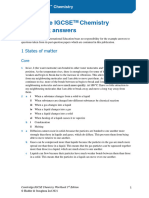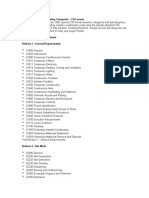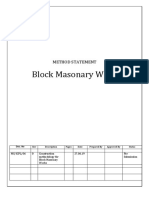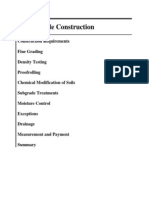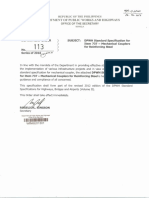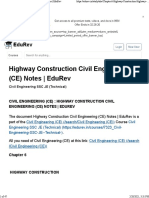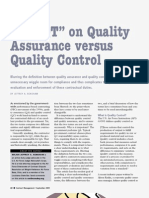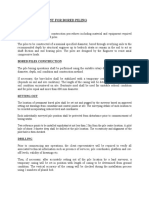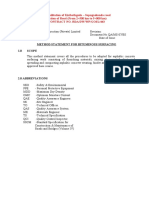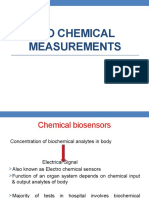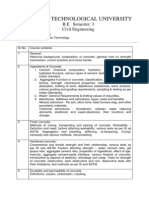Slump Test PDF
Slump Test PDF
Uploaded by
Gireesh BadoniCopyright:
Available Formats
Slump Test PDF
Slump Test PDF
Uploaded by
Gireesh BadoniOriginal Title
Copyright
Available Formats
Share this document
Did you find this document useful?
Is this content inappropriate?
Copyright:
Available Formats
Slump Test PDF
Slump Test PDF
Uploaded by
Gireesh BadoniCopyright:
Available Formats
Chapter 9 Standard Test Procedures
Tests On Concrete
CHAPTER 9
TESTS ON CONCRETE
9.1 Slump Test
9.1.1 Scope
The strength of concrete of a given mix proportion is seriously affected by the degree
of its compaction. It is therefore important that the consistency of the mix is such that
the concrete can be transported, placed and finished sufficiently easily and without
segregation. A concrete satisfying these conditions is said to be workable.
Workability is a physical property of the concrete depending on the external and
internal friction of the concrete matrix; internal friction being provided by the
aggregate size and shape and external friction being provided by the surface on
which the concrete comes into contact with.
Consistency of concrete is another way of expressing workability but it is more
confined to the parameters of water content. Thus concrete of the same consistency
may vary in workability. One test which measures the consistency of concrete is the
slump test. It does not measure the workability of concrete but it is very useful in
detecting variations in the uniformity of a mix of given nominal proportions.
Mixes of stiff consistency have zero slump. In this dry range no variation can be
detected between mixes of different workability. In a lean mix with a tendency to
harshness a true slump can easily change to the shear slump or even to collapse.
Different values of slump can be obtained from different samples of the same mix.
Despite the limitations, the slump test is very useful on site as a check on the day-to-
day or hour-to-hour variations in the materials being fed into the mixer.
An increase in slump may mean, for instance, that the moisture content of aggregate
has unexpectedly increased; another cause would be a change in the grading of
aggregate, such as a deficiency in sand. Too high or too low a slump gives
immediate warning and enables the mixer operator to remedy the situation.
9.1.2 Apparatus
9.1.2.1 Mould. A mould made of metal not readily attacked by cement paste and not thinner
than 1.5mm. The interior of the mould should be smooth and free from projections
such as protruding rivets and shall be free from dents. The mould shall be in the form
of a hollow frustum of a cone having the following dimensions:
a) diameter of base = 200mm plus or minus 2mm
b) diameter of top = 100mm plus or minus 2mm
c) height = 300mm plus or minus 2mm.
The base and top shall be open and parallel to the axis of the cone. The mould shall
be provided with two handles at two-thirds of the height, and with foot pieces to
enable it to be held steady. A mould which can be clamped to the baseplate is
acceptable, provided that the clamping arrangement can be released without
movement of the mould.
MAY 2001 Page 9.1
Chapter 9 Standard Test Procedures
Tests On Concrete
9.1.2.2 Scoop, approximately 100mm wide.
9.1.2.3 Sampling tray, 1.2m x 1.2m x 50mm deep made from minimum 1.6mm thick non-
corrodible metal.
9.1.2.4 Square mouthed shovel, size 2 in accordance with BS 3388.
9.1.2.5 Tamping rod, made out of straight steel bar of circular cross section. 16mm
diameter, 600mm long with both ends hemispherical.
9.1.2.6 Rule, graduated from 0mm to 300mm at 5mm intervals.
9.1.3 Performing Slump test
9.1.3.1 Procedure. Commence the slump test as soon as possible after sampling of
concrete as per standard procedure described in Chapter 2.
9.1.3.2 Preparation of sample for test. Empty the sample from the container onto the
sampling try. Thoroughly mix the sample by shovelling to form a cone on the
sampling tray. and turning this over to form a new cone, the operation being
repeated three times. When forming the cone deposit each shovelful of the material
on the apex of the cone so that the portions which slide down the sides are
distributed as evenly as possible and so that the centre of the cone is not displaced.
Flatten the third cone by repeated vertical insertion of the shovel across the apex of
the cone, lifting the shovel clear of the concrete after each insertion.
9.1.3.3 Test. Ensure that the internal surface of the mould is clean and damp but free from
excessive moisture before commencing the test. Place the mould on a smooth,
horizontal, rigid and non-absorbent surface free from vibration and shock.
Hold the mould firmly against the surface below. Using the scoop fill the mould in
three layers, each approximately one-third of the volume of the mould when tamped.
Tamp each layer with 25 strokes of the tamping rod, the strokes being distributed
uniformly over the cross section of the layer. Tamp each layer to its full depth,
ensuring that the tamping rod does not forcibly strike the surface below when
tamping the first layer and only passes through the second and top layers into the
layers below. Heap the concrete above the mould before the top layer is tamped.
After the top layer has been tamped strike off the concrete level with the top of the
mould with a sawing and rolling motion of the tamping rod. With the mould still held
down, clean from the surface below any concrete which might have fallen onto it.
Remove the mould from the concrete by raising it vertically, slowly and carefully, in 5
seconds to 10 seconds, in such manner as to impart minimum lateral or torsional
movement to the concrete. The entire operation from start to finish shall be carried
out without interruption and shall be completed within 150 seconds. Immediately after
the mould is removed, measure the slump to the nearest 5mm by using the rule to
determine the difference between the height of the mould and of the highest point of
the specimen being tested.
Note. The workability of a concrete mix changes with time due to the hydration of
the cement, and loss of moisture.
MAY 2001 Page 9.2
Chapter 9 Standard Test Procedures
Tests On Concrete
9.1.3.4 Expression of result
9.1.3.4.1 General. The test result is only valid if it yields a true slump. The slump should be
reported to the nearest 5mm and the type of slump (i.e. true, shear or collapse)
should be stated as shown in Figure 9.1.1 a), b) and c).
9.1.3.4.2 Precision. For slump measurements made on concrete taken from the same
sample, the repeatability is 15mm at the 95% probability level, for normal concrete
having a measured slump within the range of 50mm to 75mm.
9.1.4 Report
The following information shall be included in the report:
a) Name of testing agency
b) Client
c) Contract name
d) Location of concrete in structure
e) Supplier of concrete
f) Date and time of test
g) Time of completion of test
h) Location of test
i) Time lapsed from sampling to commencement of test
j) Form of slump, whether true, shear or collapse
k) Measure of true slump
l) Name and signature of sampler and tester
A form of reporting the slump test results is shown in Form 9.1.1.
Figure 9.1.1
True Slump Shear Collapse
a)Intact and symmetrical b) Shear c) Collapse
MAY 2001 Page 9.3
Chapter 9 Standard Test Procedures
Tests On Concrete
MAY 2001 Page 9.4
You might also like
- Cambridge IGCSE Chemistry ANSWERS Workbook Third EditionDocument43 pagesCambridge IGCSE Chemistry ANSWERS Workbook Third EditionNermine Abdel Gelil86% (7)
- Listing of Sample Estimating CategoriesDocument7 pagesListing of Sample Estimating Categoriescadevida100% (1)
- Quality Assurance Vs Quality ControlDocument17 pagesQuality Assurance Vs Quality ControlSiddharth ChakkarwarNo ratings yet
- Bituminous Mix LectureDocument41 pagesBituminous Mix LectureMohammad Ali Salem Mauna100% (1)
- Mahmoud Khlifa Almoghazy Aliraqi 2 Civil Engineering Section 21Document119 pagesMahmoud Khlifa Almoghazy Aliraqi 2 Civil Engineering Section 21Nasir AlsalehNo ratings yet
- Block Masonary Work: Method StatementDocument5 pagesBlock Masonary Work: Method StatementAneel KumarNo ratings yet
- Proctor Standard Comp Action TestDocument9 pagesProctor Standard Comp Action TestlipasemasNo ratings yet
- SPEC BrickworkDocument4 pagesSPEC BrickworkyantieschumiNo ratings yet
- Curbstone Method StatmentDocument2 pagesCurbstone Method StatmentAlHussien QadryNo ratings yet
- Ms For Rubbed ConcreteDocument6 pagesMs For Rubbed Concreteᜇᜒᜌᜓᜈᜎ᜔ᜇ᜔ ᜊᜒᜇᜓᜌ᜔No ratings yet
- Division 2Document10 pagesDivision 2Luis Gabriel BautistaNo ratings yet
- Earthworks Chapter 07Document8 pagesEarthworks Chapter 07Taqi ZaidiNo ratings yet
- Water Proofing SpecificationDocument1 pageWater Proofing Specificationprabhu81No ratings yet
- Section 3 Anti Termite WorkDocument13 pagesSection 3 Anti Termite WorkAmarendra KeerthiNo ratings yet
- Excavation, Filling and Grading 1.1 Excavation: Building SpecificationsDocument3 pagesExcavation, Filling and Grading 1.1 Excavation: Building Specificationsjoanna carrenNo ratings yet
- Methodology For Convreting WorksDocument7 pagesMethodology For Convreting WorksLokesh SaranNo ratings yet
- Strategic Recommendations For Improving Practices in Construction Industry PDFDocument34 pagesStrategic Recommendations For Improving Practices in Construction Industry PDFDamian CarlaNo ratings yet
- Field Tests of Building MaterialsDocument4 pagesField Tests of Building Materialssmartman3550% (2)
- Method of Statement VerticalityDocument1 pageMethod of Statement VerticalityMohd Hafizul Hj TanalolNo ratings yet
- STANDARD FORM OF BIDDING DOCUMENTS FOR PROCUREMENT OF WORKS (For Small Contracts)Document84 pagesSTANDARD FORM OF BIDDING DOCUMENTS FOR PROCUREMENT OF WORKS (For Small Contracts)Usman ShahidNo ratings yet
- Scaling Concrete SurfaceDocument2 pagesScaling Concrete SurfaceaaNo ratings yet
- DO - 113 - s2016 - Item 737 Mechanical Couplers For RSBDocument5 pagesDO - 113 - s2016 - Item 737 Mechanical Couplers For RSBRay Ramilo100% (2)
- Doc. Ref. R - N - I D P:::: 0 09/04/2019 1 2: ISB/MSM/EW/01Document2 pagesDoc. Ref. R - N - I D P:::: 0 09/04/2019 1 2: ISB/MSM/EW/01PuzzelsProductionNo ratings yet
- CHB LayingDocument32 pagesCHB LayingCrizza Joyce CruzNo ratings yet
- Manual of Cement Testing: For Safety PrecautionsDocument18 pagesManual of Cement Testing: For Safety Precautionshinosgar_hmNo ratings yet
- SIWES Buk 500 - FinakDocument45 pagesSIWES Buk 500 - FinakUmar James YakubuNo ratings yet
- Fresh ConcreteDocument28 pagesFresh ConcreteAmar WadoodNo ratings yet
- Technical Specification (Roads)Document8 pagesTechnical Specification (Roads)Richard Westony100% (1)
- Bored Piling: Method StatementDocument8 pagesBored Piling: Method StatementKMHoNo ratings yet
- CONSTRUCTION METHODS RoadsDocument4 pagesCONSTRUCTION METHODS RoadsAngelicaNo ratings yet
- Concrete Mix Design Beng 2021Document31 pagesConcrete Mix Design Beng 2021musinguzi robertNo ratings yet
- Presentation of Equipment Used For Pile DrillingDocument18 pagesPresentation of Equipment Used For Pile DrillingRaja BilalNo ratings yet
- Highway Construction Civil Engineering (Ce) Notes - EdurevDocument47 pagesHighway Construction Civil Engineering (Ce) Notes - Edurevmohannad eliassNo ratings yet
- Notes, Standard Forms and Preliminaries: Proposed Renovation and Extension of The Agriculture Laboratory BuildingDocument65 pagesNotes, Standard Forms and Preliminaries: Proposed Renovation and Extension of The Agriculture Laboratory Buildingkasiva cindyNo ratings yet
- Sieve AnalysisDocument51 pagesSieve AnalysisBadar Hayat100% (1)
- Presentation of RTT SitesDocument23 pagesPresentation of RTT Sitestheway2pawan100% (1)
- NO.76 Method Statement for Chemical Anchoring of Rebars on Piles - Rev.0第一次Document5 pagesNO.76 Method Statement for Chemical Anchoring of Rebars on Piles - Rev.0第一次Amila Priyadarshana DissanayakeNo ratings yet
- CIE 311 - 1 Construction MaterialsDocument15 pagesCIE 311 - 1 Construction MaterialsPenelope MalilweNo ratings yet
- Qa Verses QCDocument6 pagesQa Verses QCM-NazimNo ratings yet
- Di Pa FinalllllllllDocument62 pagesDi Pa FinallllllllllouryNo ratings yet
- A Methiod Statmnent For Bore PilingDocument4 pagesA Methiod Statmnent For Bore PilingCharith SubasingheNo ratings yet
- Visual Stability IndexDocument2 pagesVisual Stability IndexCristina OteroNo ratings yet
- Building Technology 1: Research WorkDocument54 pagesBuilding Technology 1: Research WorkRhobie Shayne BenogsodanNo ratings yet
- Sub Grade and Sub Base For Concrete PavementDocument12 pagesSub Grade and Sub Base For Concrete PavementGlaydelle Bawalan Mañosa100% (1)
- Lab Report 11 Slump of Hydraulic Cement ConcreteDocument4 pagesLab Report 11 Slump of Hydraulic Cement ConcreteLeny Agrabio AlaroNo ratings yet
- Itp Piling Rev.cDocument18 pagesItp Piling Rev.cEarl Pamintuan GoNo ratings yet
- Method Statement For Cast-In-Site DrianDocument8 pagesMethod Statement For Cast-In-Site Drian张文亮No ratings yet
- Highway EngineeringDocument73 pagesHighway Engineeringronnie oraleNo ratings yet
- Method Statement SurveyDocument3 pagesMethod Statement SurveyBadhur ZamanNo ratings yet
- Conducting A Compressive Strength TestDocument8 pagesConducting A Compressive Strength TestCeleste Amor Factor100% (1)
- Soil InvestigationDocument3 pagesSoil InvestigationMiey SahajaNo ratings yet
- Quality Plan IKANODocument30 pagesQuality Plan IKANOLilija BreivaNo ratings yet
- Problems and SolutionsDocument24 pagesProblems and SolutionsMichael Dixon0% (1)
- The Crack Pattern of Some Specimens and The Strengthening ArrangementDocument10 pagesThe Crack Pattern of Some Specimens and The Strengthening Arrangementkakem61No ratings yet
- 5 Concrete Structure Defects (Causes & Prevention & Repair) - M&CDocument17 pages5 Concrete Structure Defects (Causes & Prevention & Repair) - M&CsatpalNo ratings yet
- Early Cracking of Concrete PavementDocument25 pagesEarly Cracking of Concrete PavementRajesh KhadkaNo ratings yet
- Field Density TestDocument15 pagesField Density TestSohail Khan100% (1)
- Bitumenous SurfacingDocument6 pagesBitumenous SurfacingChemicro Holdings100% (1)
- Quality Control Manual: Issued By: Pidb Punjab PWD B&RDocument107 pagesQuality Control Manual: Issued By: Pidb Punjab PWD B&RPerkresht PawarNo ratings yet
- Slump Test PDFDocument4 pagesSlump Test PDFBisma GullNo ratings yet
- Job 9 - 0001Document5 pagesJob 9 - 0001Flee BodyNo ratings yet
- 122340hcb ProductionDocument8 pages122340hcb ProductionYared100% (1)
- Biochemical MeasurementsDocument25 pagesBiochemical Measurementsulaga nathanNo ratings yet
- Hollow Section Joints in TrussesDocument43 pagesHollow Section Joints in Trussesprabhu81No ratings yet
- Document Transmittal: SAW-CWCO-TR149 15 January 2013Document8 pagesDocument Transmittal: SAW-CWCO-TR149 15 January 2013Budi IndraNo ratings yet
- Gujarat Technological University: B.E Semester: 3 Civil EngineeringDocument2 pagesGujarat Technological University: B.E Semester: 3 Civil EngineeringMeghana ShahNo ratings yet
- B1 Reject Product 19.06.2020Document70 pagesB1 Reject Product 19.06.2020Trường XuânNo ratings yet
- Homogenizer OverviewDocument3 pagesHomogenizer Overview9567592146No ratings yet
- API 9A 2020-Addendum2023Document4 pagesAPI 9A 2020-Addendum2023Erick Santiago CubillosNo ratings yet
- SHS250 SHS200 To ConcBeam Rev01 Alter 021122Document104 pagesSHS250 SHS200 To ConcBeam Rev01 Alter 021122HongducBuiNo ratings yet
- AIR TECH Complete ManualDocument33 pagesAIR TECH Complete ManualEvandro OliveiraNo ratings yet
- Chaubey-Jain2017 Article InvestigationsOnMicrogeometryODocument15 pagesChaubey-Jain2017 Article InvestigationsOnMicrogeometryOranim najibNo ratings yet
- Vitrified Ceramic Materials For Electrical Applications: Standard Test Methods ForDocument5 pagesVitrified Ceramic Materials For Electrical Applications: Standard Test Methods ForRaheelaNo ratings yet
- Poly Butadiene PDFDocument3 pagesPoly Butadiene PDFHamzah A. LaftaNo ratings yet
- NEW AWWA C504蝶阀Document16 pagesNEW AWWA C504蝶阀Not BadNo ratings yet
- Sist en 13755 2008Document9 pagesSist en 13755 2008AnelNo ratings yet
- Provisional Restorations An Overview of MaterialsDocument4 pagesProvisional Restorations An Overview of Materialssamira chatilaNo ratings yet
- Limpieza de Contactores PDFDocument3 pagesLimpieza de Contactores PDFjimeno115No ratings yet
- Norton WeldingMetalFabCatalog 2011Document182 pagesNorton WeldingMetalFabCatalog 2011RSR_2K5364No ratings yet
- Chemistry Tshirt ProjectDocument7 pagesChemistry Tshirt Projectapi-524483093No ratings yet
- CCDC PTP Ol 03 Lahar Sandy As Backfill MaterialDocument11 pagesCCDC PTP Ol 03 Lahar Sandy As Backfill MaterialCCDC PTP MabalacatNo ratings yet
- An Experimental and Theoretical Study On The Tailings Dam With Geotextile BagsDocument12 pagesAn Experimental and Theoretical Study On The Tailings Dam With Geotextile Bagsgabriela.p.alfaro.aNo ratings yet
- Pass I VationDocument1 pagePass I VationSankar100% (1)
- Microstructures of The Commercial 7075 AI Alloy in The T651 and T7 TempersDocument2 pagesMicrostructures of The Commercial 7075 AI Alloy in The T651 and T7 TempersPutra Temas ToyebNo ratings yet
- 1 2 2 5 2 PDFDocument16 pages1 2 2 5 2 PDFSrinivas VenkataramanNo ratings yet
- Injection Molding of RubberDocument39 pagesInjection Molding of Rubberadhitya100% (1)
- Chem2006MS JUNE ALL UNITSDocument89 pagesChem2006MS JUNE ALL UNITSiratuzipacifique2No ratings yet
- White CementDocument5 pagesWhite CementAhmed Younis100% (1)
- Laser Technique DifferentDocument2 pagesLaser Technique DifferentGoutam Kumar DebNo ratings yet
